By Amanda Buchanan
Cucurbits in Michigan are vulnerable to squash bug damage throughout the growing season. Squash bugs prefer pumpkin and squash, but will feed on other cucurbits like cucumber and watermelon. Squash bug juveniles and adults can cause significant damage to foliage and fruits.
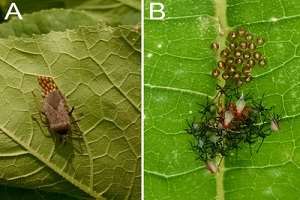
Figure 1. (A) Squash bug adult laying eggs, and (B) newly hatched eggs and early nymphs. Photo credit: A.L. Buchanan
Appearance
Squash bugs lay clusters of 10-20 eggs on the surface or underside of leaves between leaf veins, or on the stem (Fig 1A). Eggs are small, oblong, and a shiny copper color. Upon hatching, nymphs are green with red legs and antennae, which turn black within hours (Fig 1B).
As nymphs mature their bodies become gray (Fig 2A). Adults are flat-bodied, about 5/8 inch long, black and brown with light and dark stripes along the side (Fig 2B). Nymphs will often be seen clustered together, while adults are found singly or in mating pairs. Adults can fly but generally walk on the ground between plants, where they are well-camouflaged.
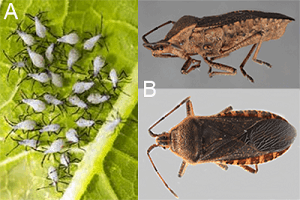
Figure 2. (A) Squash bug late nymphs, and (B) adults. Photo credit: A.L. Buchanan, W.R. Morrison III
Life cycle
Adults overwinter indoors or in leaf litter or field debris, and emerge in April or May to lay eggs. Nymphs hatch within 10 days and begin to feed, reaching adult stage in 35-40 days. Squash bugs have one generation per year in Michigan, but all life stages can be observed at any time of the season.
Similar species
The horned squash bug feeds on cucurbits, but is less damaging than the squash bug. Horned squash bugs have more prominent spines on the head. Similar herbivorous insects include leaf-footed bugs (Fig 3), which are less likely to cause serious damage to cucurbits than squash bugs.
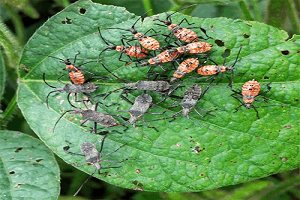
Figure 3. Other insects, like leaf-footed bugs, may appear similar to squash bugs but are an not economically important pest of cucurbits. Photo credit: P.L. Coffey
Squash bug adults may also be confused with assassin bugs (Fig 4A) or spined soldier bugs (Fig 4B). Assassin bugs typically have a more sculpted body and a spiny exterior. Spined soldier bugs are shield-shaped with distinctly pointed shoulders. Both of these insects are beneficial predators and their presence should be encouraged.
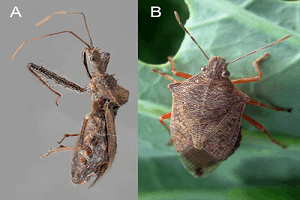
Figure 4. The (A) assassin bug and (B) spined soldier bug are beneficial predators. Photo credit: W.R. Morrison III
Damage
Squash bugs prefer squash and pumpkins but will feed on other cucurbits. Adults and nymphs feed on leaves and fruit by piercing and sucking plant juices, damaging plant tissue and potentially spreading disease. Leaf damage causes brittle discolored spots or wilting (Fig 5A-B). Fruit becomes disfigured and discolored (Fig 5C).
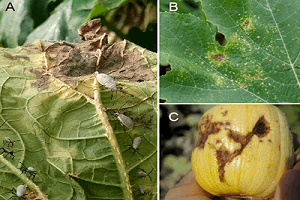
Figure 5. Squash bug damage on (A-B) leaves and (C) fruits. Photo credit: A.L. Buchanan, W.R. Morrison III
Management
Visual scouting for all life stages of squash bugs should occur from June to September. Insecticides are most effective on young squash bug nymphs (Fig 1B) compared to other life stages.
- At cucurbit seedling stage, the threshold for chemical control of squash bugs is any squash bug presence.
- After the seedling stage, the threshold for chemical control is one egg mass per plant.
Cultural and biological controls
Removing field debris after harvest reduces overwintering habitat for adult squash bugs. Trap cropping can be used to exploit squash bugs’ preference for squash and pumpkin—planting a border or small plot of squash or pumpkin near less-preferred cucumber or watermelon crops can attract squash bugs away from cucumber and watermelon fields. Natural enemies can help manage pest populations: spiders, lady beetles, ground beetles, lacewings, and nematodes feed on pests, and parasitoid wasps and flies kill pest eggs.
Source: msu.edu